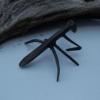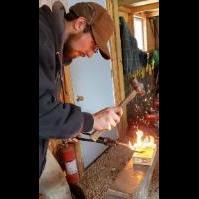-
Posts
297 -
Joined
-
Last visited
About rustyanchor

Profile Information
-
Gender
Male
-
Location
Columbia KY
-
Interests
Metal working, wood working, wandering in the woods...
Recent Profile Visitors
2,636 profile views
-

Anvil Identification and use of shelf?
rustyanchor replied to B3NDY's topic in Anvils, Swage Blocks, and Mandrels
Nice! Small dents and rough spots will wear in as you work on it, so nothing to really do but use it. From what I read a little sway is fine, and is useful in straightening stock. Sounds like you found a very nice anvil at a very nice price. Enjoy -

Anvil Identification and use of shelf?
rustyanchor replied to B3NDY's topic in Anvils, Swage Blocks, and Mandrels
B3NDY, I have a later Mousehole-1920's vintage, and it has a steel plate welded to what I assume is a wrought top. Not sure what the date on the posted ad is, but Brooks and Cooper was an earlier trademark 1875 to 1880 or so, for Mousehole. They eventually went back to M&H Armatage Mousehole. You will only get a real idea of what you are looking at if you can see what trademark, if any, is on the side opposite from the one pictured. You asked if Mouses have any known issues, I absolutely love my Mouse, I don't think I have ever heard any complaints about them. I would guess that Mousehole or PW are the most common English anvils in the US, and English anvils seem to be the most common imported anvils. We didn't start producing anvils in the US in great quantities until the mid 1800s. -
The handy thing about the Stephens design is: I can pull the lever partially and slide the jaw closed on whatever I am clamping and it will hold it, then I can pull the lever to apply more clamping pressure. Handy if I am positioning something with both hands, using my body to slide the jaw closed. Sort of like a ratcheting mechanism.
-
Here is the Stephens 1870 patent and a 3" Stephens vise. My cousin has/had the twin to this one. The pictured vise is my main shop vise and still works like a champ. From what I have been able to dig up on these vises, most were very small and had a swiveling base mechanism for jewelers type work. Stephens vice patent.pdf
-
Farmall, Well... I know Trenton and AH are reputed to have used the same cast bases, the top half of the both anvils are forged, but I don't know how they handled the upper half of the anvil for the forge welding. Later AH were arc welded at the waist. I have seen one of those, and it looked like AH used a huge welding rod for the process. AIA talks about the switch to arc welding sometime around the time the AH forge/buildings burned down.
-
Farmall, My guess by the weight and S/N on the front foot and caplet on the base is an early 70 pound Trenton. AH if I remember correctly had either weight or S/N on the side below the logo. In any event it is a nice looking anvil.
-
Duncan, From what I read on a different form, the blade guides changed a few times over the A7s run, mine has large steel guides, that were very easy to adapt a table to. I will get a pic of what I came up with. It is no work of art but it works for how I use the saw.
-
Could be, but it would be an awful small shaft for a cute little boat.
-
Duncan, You did well on the price. I have an A7 made in '75. It has been a good saw for me, it sure beats a hacksaw and busted knuckles. I made a table that bolts to the lower blade guide to use mine as a vertical saw. Enjoy.
-
No handling holes is a clue of some sort. How is the ring and rebound?
-

blacksmithing question?
rustyanchor replied to GeorgeStevens's topic in Blacksmithing, General Discussion
George, Everyone of us started somewhere, most with what you have now: A desire to learn and maybe a few tools. There is so much information on this site, you can spend days or weeks researching something and have a really good understanding at the end. Use the resources available on here, the members on here want to see newbies succeed and will help you and guide you if you have tried to find an answer and it still doesn't make sense. When I was 13, I would ride my bike around and scrounge the odd places people dumped their junk. I would drag all sorts of bits and pieces home. People throw all sorts of very useful stuff away because they don't want to fix it, or don't know how to. Yard sales and such are possible sources for cheap tools. Fill in the location info in your profile and you may find help closer than you think. -

Trexton Anvil. Looking for a price
rustyanchor replied to ebuonarosa's topic in Anvils, Swage Blocks, and Mandrels
Your neighbor sounds like he/she is "silly" and trying to play you like a cheap fiddle. Or maybe they are just ignorant. Send them to Harbor Fright for a brand spanking new, high quality, top of the line, imported, cheap cast iron anvil, in their price range. Everybody knows you could walk into the Trenton/Trexton showroom and buy them brand new for around 20 cents a pound, in 1920 or so. You may find someone that you feel would benefit from your anvil, and maybe you give them a deal, but that is your call. When I finish using my tools for good, I hope they go to someone who will use and appreciate them, but by that time it will not matter to me. -
I need to cite the reference for the above post, and clarify what is speculation on my part. Most of the info comes from Anvils in America (AIA) by Richard Postman. Your logo was used from about 1911 to the forge shut down in 1933. The highest S/N RP has seen is 24342 from 1911. Your S/N is 37xxx, so I would speculate a very late production. I hope you enjoy it.
-
You have a very nice mouse. The Sheffield England stamping and high S/N, indicate it was a late production (1920s/30s) anvil. The forge ceased production in 1933. I have a 100 pound mouse from the same late production era, it is a sweet anvil to work on. I put it on a metal stand, bedded in silicone, with chains on the waist, and the ring is minimal. Enjoy your mouse.
-
You ended up with a much nicer anvil than the original you posted. The miss on the Soderfors was a fortunate for you. A little wire wheel and elbow grease and she'll be ready to rock.




